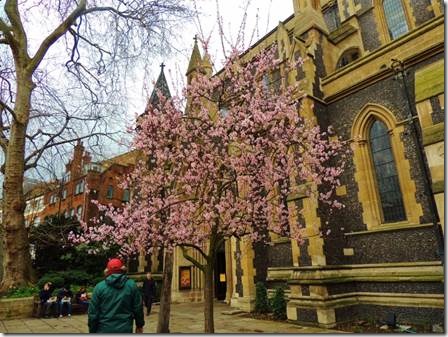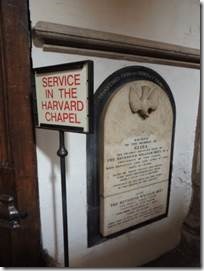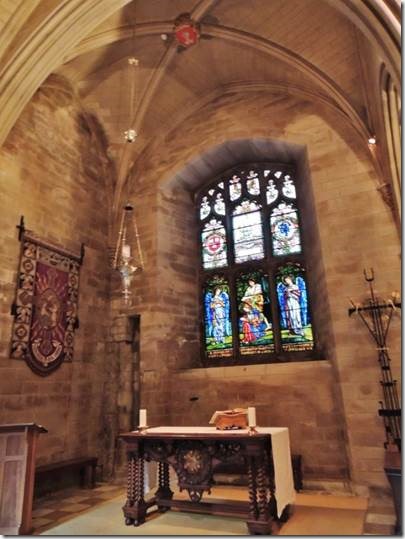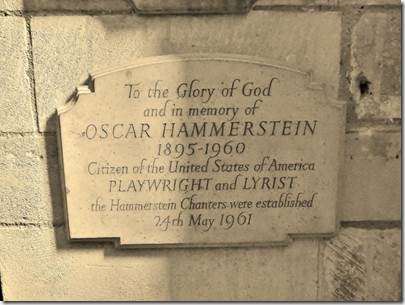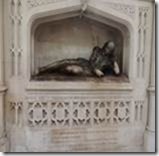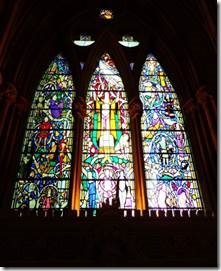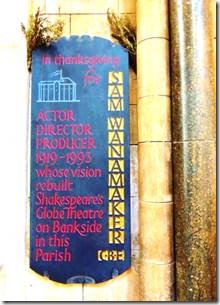Cheers,
Randal needed more fiber pills (he’s not much for fruit or veggies) so we walked down Borough Street to the Holland and Barrett shop to buy some. Southwark Cathedral is just nearby so we stopped in to take the “American Connection” photos. The Cathedral was crowded, Vivien wasn’t there and the John Harvard Chapel was closed for a service. Oh, and the café was too crowded to find a table. Other than that…. My researching turned up some interesting tidbits….
Ru
Southwark Cathedral Part 2 : The American Connection.
|
“It’s Spring, Sir!” Corporal Klinger in MASH I always think of that line when I see the first inklings of spring which we have now in London. I’m told it’s really a bit too early but lots of trees and flowers are blooming. |
|
Just across from the flowering tree in the south churchyard is the memorial to Mahomet Weyonomon, Sachem of the Tribe of the Mohegans. Mahomet Weyonomon memorial “On 22 November 2006 HM The Queen accompanied by HRH Prince Philip visited the Cathedral to unveil a granite boulder from Connecticut in the churchyard to commemorate the Sachem Mahomet Weyonomon. The story goes back to an entry in the Daily Journal for August 11th, 1736: On Sunday last about one o’clock in the Morning died of the Small Pox, in the 36th Yeare of his Age, Mahomet Weyonomon, Sachem of the Tribe of the Mohegans in the Province of Connecticut in New England. He was Great Grandson to the famous Sachem Uncafs or Onkafs, who took part with the English upon their firft fettling of that Country. He was very decently interred laft Night (from his Lodgings at Mr Midhurst’s in Aldermanbury) in St Mary Over’s Burial-place. The background to the story is the familiar colonial tale of settlers appropriating the land belonging to the original native population. In this case it was the tribal lands belonging to the Mohegans in Connecticut. When the settlers first took the land, Mahomet’s grandfather Oweneco came to England to petition Queen Anne. The Queen ordered a commission who found in favour of the Indians that they were unjustly deprived of their lands and the governor and company of the Colony of Connecticut was ordered to return the lands. Not only was this ignored but further encroachments took place. to the point where the Mohegans were unable to subsist on the remaining territory. So in 1735 Mahomet Weyomon accompanied by John Mason, his son Samuel and Zachary Johnson came to London to petition King George II for restoration of their lands. They lodged in the City in the Ward of St Mary Aldermanbury. But before they could present the petition the whole party died of smallpox. The city authorities were happy to bury Mahomet’s European companions in the City but Mahomet had to be buried in the churchyard of St Mary Overy. It was quite a common custom at that time for burials to take place at night and we may imagine what a dramatic spectacle it was when the body was brought by torchlight over London Bridge. At the unveiling ceremony in November, present with the Queen was the tribal chairman Bruce Two Dogs Bozsum and other members of the tribe. An audience with the monarch that failed in 1735 was finally achieved. The monument was carved by Peter Randall Page. “ http://cathedral.southwark.anglican.org/visit/usa-connections http://www.washingtonpost.com/ is the Washington Post story. http://www.peterrandall-page.com/ photo of the unveiling and explanation by the artist of his sculpture which originally was sitting on the grass to look as if it indeed was rising from below. Now not so much. I actually thought it was supposed to represent a Native American Indian burial ground. |
|
John Harvard Chapel and the Harvard family of Southwark “The baptismal records for St Saviour’s Church (now Southwark Cathedral) record that the son of parishioners Robert and Katherine Harvard was baptised here on 29 November 1607. He was given the name John. Robert was a prominent businessman who had a butcher’s business in Pepper Alley and was also warden of St Saviour’s. John lost many family members, including his father, in the Southwark Plague. His mother Katherine went on to remarry, possibly twice more. However, after the death of both his mother and elder brother, John and his wife Ann left for Massachusetts in 1637. He died of consumption in 1638 and left half his estate and his library of books to the proposed new college, now known as Harvard University. The Harvard Chapel in the Cathedral commemorates this ‘godly gentleman and lover of learning’.” http://cathedral.southwark.anglican.org/visit/usa-connections |
|
John Harvard and Oscar Hammerstein II The John Harvard Chapel A service was being conducted in the chapel; these photos are from my first visit. John La Farge Stained Glass Windows The window in the Harvard Chapel is by the New York stained glass artist, John La Farge. It was commissioned and paid for by Joseph Hodges Choate (1832-1917), himself a Harvard graduate. Choate had an illustrious career in law, and headed many organizations, including the Union League Club and the Century Association. A life-long Republican, he was appointed Ambassador to the Court of St James’s in London in 1899, where he worked closely with John Hay, Secretary of State, on the territorial treaties between the US and Britain concerning Canada. The main subject is the Baptism of Christ, alluding to the baptism of John Harvard in the church in 1607. This depiction is after Nicolas Poussin. On the upper left are the arms of Harvard University and on the right those of Emmanuel College, Cambridge, where Harvard studied. In the centre are the Royal Arms, as they appeared between 1415 and 1603; however, the supporters and crest are of a later period, probably dating from the restoration carried out in 1948. Charles Morton, another Harvard link to Southwark…. In 1686 Charles Morton, son of Nicholas Morton, rector of St Saviour’s (now Southwark Cathedral) emigrated to Massachusetts, where he became Fellow and Vice-President of Harvard. |
|
Twice at our morning cruiser coffees when Southwark Cathedral has been mentioned, so has the name of John Harvard. And that’s when the debate begins. The stained glass windows in the John Harvard chapel proclaim John Harvard as the founder of Harvard College. However, in telling its own history, Harvard University acknowledges its establishment in 1636 “by vote of the Great and General Court of the Massachusetts Bay Colony.” So why is Harvard called Harvard? “By the time John Harvard died, he knew what he wanted to do with his estate. Of course he had to take care of his wife, who received half his money. The remainder, £800 (twice the sum granted by the colony’s General Court in 1636 for the establishment of a college) and his entire library, he gave to the new school in Cambridge. The bequest ensured that his name would never be forgotten.” http://harvardmagazine.com/2000/01/john-harvard.html Harvard is the oldest institution of higher education in the United States, established in 1636 by vote of the Great and General Court of the Massachusetts Bay Colony. It was named after the College’s first benefactor, the young minister John Harvard of Charlestown, who upon his death in 1638 left his library and half his estate to the institution. A statue of John Harvard stands today in front of University Hall in Harvard Yard, and is perhaps the University’s best known landmark. http://www.harvard.edu/history The John Harvard Statue at Harvard….isn’t….. 1. That isn’t John Harvard. Even though the name “John Harvard” is written in stone on the statue’s base, the likeness is not, actually, that of John Harvard. In fact, there are no living representations of John Harvard. In 1884, Daniel Chester French created the famous statue, and Sherman Hoar sat as a model for the head of John Harvard. Hoar later went on to serve as a member of Congress and a US district attorney. 2. John Harvard wasn’t the founder of Harvard University. What? Yes, that’s right. The engraving on the statue states “founder,” but this is also not true. Actually, Harvard didn’t even attend the College. He was the first major benefactor to the University. He donated half of his estate and his library, which consisted of over 400 books.
Harvard University was officially founded by a vote by the Great and General Court of the Massachusetts Bay Colony. http://www.summer.harvard.edu/blog-news-events/3-lies-harvard |
|
Oscar Hammerstein II: Plaque located in the John Harvard Chapel “Inside the Chapel there is a plaque to Harvard-educated Oscar Hammerstein II*. Oscar fell in love with the English Cathedral Choral tradition and would regularly visit the Cathedral and take the head boy of the Boy’s Choir to lunch with him. He gave the Cathedral Choir an endowment and two of the choir members are, to this day, known as the Hammerstein Chanters.” http://cathedral.southwark.anglican.org/visit/usa-connections *Everything I read says Hammerstein attended Columbia where he met Richard Rodgers. The rest of the information seems correct as I found news stories where Hammerstein’s widow unveiled the plaque. So I guess I’ll write to the Cathedral …. “Cathedral Plaque Honors Lyricist LONDON, May 24, 1961 UP) — Mrs. Dorothy Hammerstein, widow of Lyricist Oscar Hammerstein, unveiled a plaque to his memory in Southwark Cathedral to day. The service was attended by about 30 members of the London cast of "The Sound of Music," the last work written by Hammerstein in collaboration with composer Richard Rodgers. Mr. and Mrs. Rodgers attended the ceremony. Much of the dedicatory service was taken over by the cathedral choir. Hammerstein’s will provided 2,000 pounds ($5,~ 600) to support two choirboys at Southwark Cathedral. They are called the Hammerstein charters “ http://www.newspapers.com/newspage/10915748/ http://www.pbs.org/wnet/broadway/stars/oscar-hammerstein-ii/ |
|
Sam Wanamaker and Shakespeare “On the right of the memorial to William Shakespeare, is a memorial tablet to the American actor, Sam Wanamaker, who was the driving force behind the building of the present Shakespeare’s Globe Theatre on Bankside. His ambition was achieved despite opposition at the time from local councillors, who did not want it to become a tourist attraction. How times have changed! Unfortunately, he did not live to see his dream become a reality, dying before it opened its doors to the public.” http://cathedral.southwark.anglican.org/visit/usa-connections http://www..bbc.co.uk/news/entertainment-arts-25590351 tells the very history of the first Globe Theatre. Randal and I have not actually visited the Globe. I must say I’m much more a fan of Dickens than Shakespeare, but I will at least go take some photos of the outside one of these days. Sam Wanamaker and the McCarthy era blacklisting…. Letter: BBC program looks at the life of blacklisted actor Sam Wanamaker https://www.wsws.org/en/articles/2009/03/wana-m16.html is a really interesting story about Wanamaker’s experiences during the McCarthy era causing him to flee the US rather than testify against fellow actors. The program "Who Do You Think You Are?" on BBC 1 is the episode of actress Zoe Wanamaker, Sam’s daughter, learning of about her father from FBI files and then her Ukrainian grandparents. “Before doing this program, Zoe Wanamaker only knew snippets of her family history. She was born in New York, but when she was three her father, an American actor, director and producer, fled to the UK to escape the anti-communist McCarthyite witch-hunts. (Her mother, a radio soap star, was born in Toronto).” |
|
http://www.mydoramac.com/wordpress/?p=20765 is the link to my first visit |

